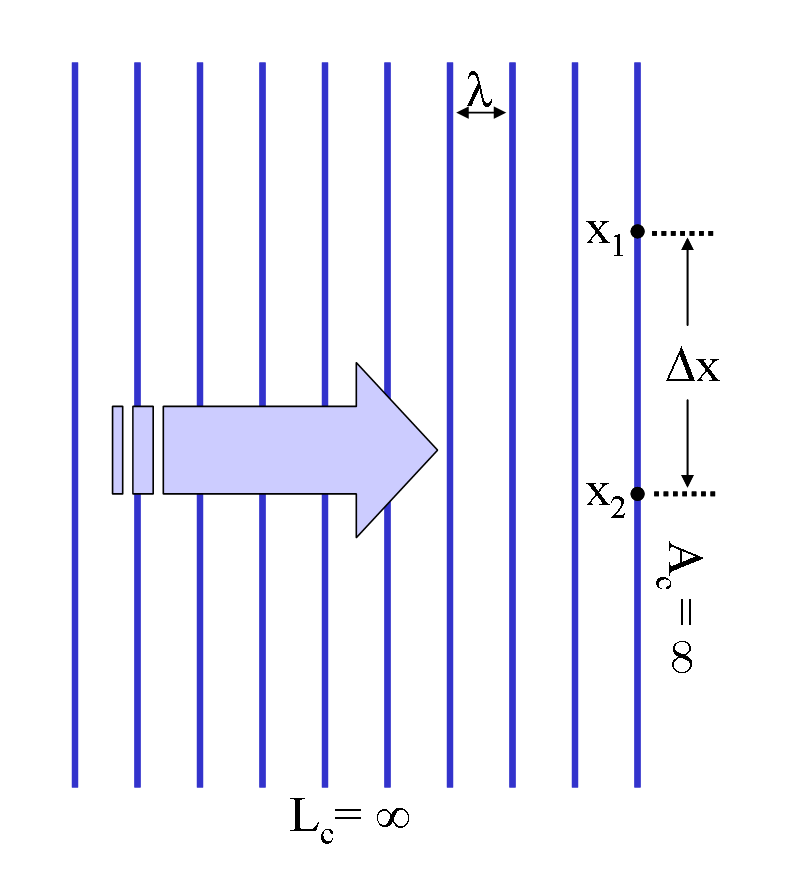The key difference between temporal and spatial coherence is that temporal coherence describes the correlation between waves that are observed at different moments in time, whereas spatial coherence refers to the correlation between waves at different points in space, which are either lateral or longitudinal.
Coherence is an important phenomenon that refers to two wave sources that are coherent if their frequency and waveform are identical. We can describe the property of coherence as an ideal property of waves that can enable stationary interference. Generally, coherence describes the correlation between physical quantities of a single wave or between some waver or wave packets.
CONTENTS
1. Overview and Key Difference
2. What is Temporal Coherence
3. What is Spatial Coherence
4. Temporal vs Spatial Coherence in Tabular Form
5. Summary – Temporal vs Spatial Coherence
What is Temporal Coherence?
Temporal coherence can be defined as the measure of the average correlation between the value of a wave and itself, delayed by T (time period of oscillation of the wave) at any pair of times. Temporal coherence can be used to describe how monochromatic a source can be. In other words, it describes the way that a wave can interfere with itself for a certain time period. The delay of this wave over which the phase or the amplitude can wander by a significant amount is named as the coherence time or “Tc.”

Figure 01: The Amplitude of a Wave (considering a single frequency as a function of time “t”)
Further, when the delay is at the state T = 0, the degree of coherence becomes perfect. However, it tends to drop significantly when the delay passes T = Tc. Moreover, another important term is coherence length, abbreviated as Lc. This can be described as the distance to which the wave travels in the time period of Tc. We need to be careful in order to avoid any confusion between the coherence time with the time duration of the signal and also the coherence length with the area of coherence.
What is Spatial Coherence?
Spatial coherence can be defined as the cross-correlation between two points in a wave for all times. For some systems, such as water waves or optics, we can observe the extension of the wave-like state over one or two dimensions. This property of spatial coherence can be used to describe the ability of two points in space named X1 and X2 (in the extent of a wave) to interfere when averaged over time.

For example, if there is only one value for a wave having an amplitude over an infinite length, we can say that it is perfectly spatially coherent. An important term regarding spatial coherence is the coherence area, which is abbreviated as Ac. It is the range of separation between two of the points over which there is a significant interference, which defines the diameter of the coherence. We can say that Ac is the relevant type of coherence that is suitable for Young’s double-slit interferometer. Moreover, this concept is useful in optical imaging systems and, more importantly, in various types of astronomy telescopes. Furthermore, some people use spatial coherence to refer to the visibility in the presence of a wave-like state that is in combination with a spatially shifted copy of itself.
What is the Difference Between Temporal and Spatial Coherence?
The key difference between temporal and spatial coherence is that temporal coherence describes the correlation between waves that are observed at different moments in time, whereas spatial coherence refers to the correlation between waves at different points in space, which are either lateral or longitudinal.
The following table summarizes the difference between temporal and spatial coherence.
Summary – Temporal vs Spatial Coherence
The key difference between temporal and spatial coherence is that temporal coherence describes the correlation between waves that are observed at different moments in time, whereas spatial coherence refers to the correlation between waves at different points in space which are either lateral or longitudinal.
Reference:
1. Pinton, Gianmarco, et al. “Spatial Coherence in Human Tissue: Implications for Imaging and Measurement.” IEEE Transactions on Ultrasonics, Ferroelectrics, and Frequency Control, U.S. National Library of Medicine, Dec. 2014.
Image Courtesy:
1. “Single frequency correlation” By Glosser.ca – Own work (CC BY-SA 4.0) via Commons Wikimedia
2. “Spatial coherence infinite ex1” By J S Lundeen at the English-language Wikipedia (CC BY-SA 3.0) via Commons Wikimedia
ncG1vNJzZmivp6x7pbXFn5yrnZ6YsqOx07CcnqZemLyue9ahmK1lmah6tbTEZpuinpaav6a6wp5km52krLKmuoytnKaon6eurXnAp5tmq6CWwaqty2aaqKCVp7Kvr8Ro